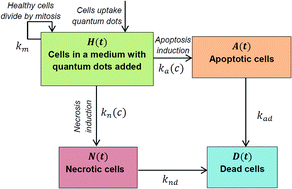An experimental and theoretical assessment of quantum dot cytotoxicity†
Abstract
Quantum dots (QDs) are a class of semiconductor nanoparticles that possess a unique set of size-tunable optical properties. The potential applications of QDs in biological and medical applications are enormous – some notable examples being in high-resolution cellular imaging, cancer tumour targeting and drug delivery. However, the mechanisms for QD-cell interactions are at best partially understood, and QD cytotoxicity is an ongoing concern. In particular, it remains unclear how QD uptake by cells and subsequent cell fate are influenced by QD parameters such as size, composition, concentration, and exposure time. To help resolve this complex issue in a systematic manner, we have developed here one of the first mathematical models that describes the toxic effects of QDs on cells. The model consists of a system of ordinary differential equations describing (among other things) the transition of healthy cells to an apoptotic or necrotic state induced by QD toxicity. We also experimentally investigated the behaviour of a cell population subsequent to exposure to various types of CdTe QDs. In a population of identical cells exposed to QDs of similar size (2–5 nm), it was found that some of the cells entered apoptosis, others entered necrosis, and others demonstrated no response at all. The toxicity of the various QDs was conveniently quantitatively assessed using the parameters appearing in the mathematical model, and satisfactory agreement between theory and experiment was found.


 Please wait while we load your content...
Please wait while we load your content...